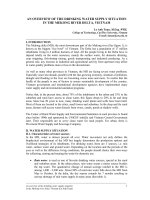Tài liệu SDI MANUAL OF CONSTRUCTION WITH STEEL DECK doc
Bạn đang xem bản rút gọn của tài liệu. Xem và tải ngay bản đầy đủ của tài liệu tại đây (707.04 KB, 47 trang )
SDI MANUAL
OF CONSTRUCTION
WITH
STEEL DECK
Steel Deck Institute
P.O. Box 25
Fox River Grove, IL 60021
phone: (847) 458-4647
fax: (847) 458-4648
........................................................................................................ page
I. PRODUCT DESCRIPTIONS ................................................................... 4
1. General - All Deck Products ................................................................ 4
2. Composite Floor Deck ......................................................................... 4
3. Roof Deck ............................................................................................ 5
4. Cellular Deck ....................................................................................... 5
5. Form Deck ........................................................................................... 6
II. APPROVED ERECTION DRAWINGS .................................................. 12
III. PACKAGING.......................................................................................... 12
IV. LOADING & SHIPPING......................................................................... 14
V. RECEIVING, UNLOADING, STORAGE & PROTECTION ................... 15
Deck Ordering Check List .................................................................. 17
VI. ERECTION OF DECK & JOB SAFETY ................................................ 18
Alertness............................................................................................. 19
Lifting .................................................................................................. 20
Fastening & Installing ......................................................................... 26
Housekeeping..................................................................................... 34
VII. DECK DAMAGE & PENETRATIONS ................................................... 35
Roof Deck ........................................................................................... 35
Penetration Example .......................................................................... 36
Details for Opening Example ............................................................. 37
Sump Pans ......................................................................................... 38
Floor Deck .......................................................................................... 40
Cantilevers Example .......................................................................... 40
VIII. PLACING CONCRETE.......................................................................... 41
IX. SPECIAL CONSIDERATIONS FOR DIAPHRAGMS ............................ 44
Construction Load Table .................................................................... 45
Deck Loading Diagram ....................................................................... 46
References ......................................................................................... 47
The Steel Deck Institute makes no representation or warranty
respecting any information contained in this manual, including but
not limited to the accuracy, completeness, or suitability of such
information for any particular purpose or use. The Steel Deck
Institute expressly disclaims any and all warranties, express or
implied. By making this information available, the Steel Deck
Institute is not rendering professional services, and assumes no duty
or responsibility with respect to any person making use of such
information. In addition, neither the Steel Deck Institute nor any of its
Members or Associate Members shall be liable for any claim,
demand, injury, loss, expense, cost or liability of any kind whatso-
ever which in any way arises out of or is connected with the use of
the information contained in this publication, whether or not such
claim, demand, loss, expense, or liability results directly or indirectly
from any action or omission of the Steel Deck Institute or any of its
Members or Associate Members. Any party using the information
contained in this manual assumes all liability arising from such use.
SDI NOTICE
TABLE OF CONTENTS
© Copyright 1992 Steel Deck Institute
2
PLEASE NOTE:
This publication was originally issued in 1992. This web site edition has
been slightly modified and edited for the electronic format. Figure 3
(page 21) has been revised from the original to illustrate proper rigging
for hoisting deck onto the structural frame.
Revisions adopted August 2000.
This manual is intended to be an aide and general guide for
the safe and proper erection of steel deck. The objectives are
safety, which is always paramount, and providing a good quality
job. This manual is not intended to define specific duties or
responsibilities of any of the participants involved in doing the
work nor is it intended to replace necessary contract documents.
Each participant-the designer, the deck manufacturer, the general
contractor, the deck erector, the owner, and each individual
worker-should be aware of their individual responsibilities, as
defined in the contract documents, so that the job environment
will be as safe as possible and also to produce a good job.
While the information presented in this manual has been
prepared in accordance with generally recognized engineering
principles and accepted construction practice, it is recommended
that it be reviewed by the design professional and the builder for
its applicability for any specific job.
ACKNOWLEDGEMENT
This publication is the result of many hours of work by
members of the Steel Deck Institute. It also greatly benefited from
the generous contributions of time, skill and knowledge of many
other organizations and individuals. In particular the SDI thanks
Professor Larry D. Luttrell of West Virginia University (Research
Advisor to the SDI) for his review and comments; Mrs. Cheryl
Janusz for editing the text; Mr. Merle Nordyke for his excellent
cartoons; Mr. John McMahon of the Institute of the Iron working
Industry for his advice; and the members of the Steel Erectors
Association of Virginia and Carolinas (SEAVAC) for their many
helpful suggestions.
Although not all suggestions for changes were implemented
in the text, we were able to accommodate most of them and to
compromise on others. As is the case with other SDI publications,
a continuing effort will be made to keep the document up to date
and to issue revisions as warranted by changes in construction
practice.
The SDI Construction Committee
3
I. PRODUCT DESCRIPTIONS______________________________
1. General-All Deck Products
Steel deck is made by cold forming structural grade sheet
steel into a repeating pattern of parallel ribs. The strength and
stiffness of the panels are a result of the shape of the ribs and the
material properties of the steel. Deck lengths can be varied to suit
job conditions but, because of shipping considerations, are usually
less than 40'. Standard deck width varies with the product used but
full sheets are usually 12", 18", 24", 30" or 36". Deck is typically
furnished in a standard width with the ends square cut. Any cutting
for width, such as at openings or for angular fit, is done at the job
site.
Deck is typically attached to the building frame with arc
puddle welds, self drilling screws or powder or pneumatically
driven pins. Sheet to sheet fastening is done with screws, button
punching (crimping), or welds
.
2. Composite Floor Deck
After installation and adequate fastening, floor deck serves
several purposes. It (a) acts as a working platform (b) stabilizes
the frame (c) serves as concrete form for the slab and (d)
reinforces the slab to carry the design loads applied during the life
of the building. Composite decks are distinguished by the
presence of shear connector devices as part of the deck. These
devices are designed to mechanically lock the concrete and deck
together so that the concrete and the deck work together to carry
subsequent floor loads. The shear connector devices can be
rolled-in embossments, lugs, holes or wires welded to the panels.
The deck profile configuration can also be used to interlock
concrete and steel.
Composite deck finishes are either galvanized (zinc coated)
or phosphatized/painted.
Phosphatized/painted deck has a bare (phosphatized) top surface
which is the side to be in contact with the concrete. This bare top
surface can be expected to develop rust before concrete is placed.
The bottom side of the deck has a primer coat of paint. (See the
next section on Roof Deck for a description of primer paint.)
Galvanized deck has a zinc coating on both sides.
Composite floor deck is normally installed so the panel ends
do not overlap on the supporting beams. Shear lugs or profile
shape often prevent a tight metal-to-metal fit if panel ends overlap.
The air gap caused by overlapping prevents proper fusion with the
structural steel when sheet end laps are shear stud welded.
Adequate end bearing of the deck must be obtained as
shown on the erection drawings. If bearing is actually less than
shown, further investigation is required.
4
3. Roof Deck
Roof deck is not designed to act compositely with other
materials. Roof deck acts alone in transferring horizontal and
vertical loads into the building frame. Roof deck rib openings
are usually narrower than floor deck rib openings. This provides
adequate support of rigid thermal insulation board.
Roof deck is typically installed to endlap approximately 2"
over supports. However, it can be butted (or lapped more than
2") to solve field fit problems. Since designers frequently use
the installed deck system as part of the horizontal bracing
system (the deck as a diaphragm), any fastening substitution
or change should be approved by the designer. Continuous
perimeter support of the deck is necessary to limit edge de-
flection in the finished roof and may be required for diaphragm
shear transfer.
Standard roof deck finishes are galvanized or primer painted.
The standard factory applied paint for roof deck is a primer
paint and is not intended to weather for extended time periods.
Field painting, touch up of abrasions and deterioration of the
primer coat or other protective finishes are the responsibility of
the buyer. It is recommended, however, that any field paint be
applied over a small test area of the primed deck and tested for
compatibility and adhesion prior to proceeding with field
painting. Special paint, or paint to be applied over galvanizing,
is available on special order but must be adequately described
to the manufacturer before bidding.
4. Cellular Deck
Cellular deck is made by attaching a bottom steel sheet to a
roof deck or composite floor deck panel. Cellular deck can be
used in the same manner as floor deck. Electrical, telephone
and computer wires are easily run through the chase created
between the deck panel and the bottom sheet.
When used as a part of the electrical distribution system, the
cellular deck must be installed so that the ribs line up and
create a smooth cell transition at abutting ends. The joint that
occurs at butting cell ends must be taped or otherwise
protected to prevent concrete from entering the cell. Cell
interiors must be free of welding burrs or other sharp intrusions
to prevent damage to wires.
When used as roof deck, the bottom flat plate is usually left
exposed to view. Care must be maintained during erection to
keep good alignment and prevent damage.
5
_PRODUCT DESCRIPTIONS_____________________
Cellular deck is sometimes used with the flat plate on the
topside
to provide a flat walking surface. Installation of deck for this purpose
requires special methods for attachment to the frame because the flat
plate-now on the top-can prevent direct access to the deck material
that is bearing on the structural steel. It may be advisable to treat the
flat top surface to prevent slipping.
Cellular deck is always furnished galvanized or painted over
galvanized.
5. Form Deck
Form deck can be any floor or roof deck product used as a concrete
form. Connections to the frame are by the same methods used to
attach floor and roof deck. Welding washers are recommended when
welding metal thickness is less than 0.0280 inches.
Form deck is furnished galvanized, prime painted or uncoated.
Galvanized deck must be used for those roof deck systems where form
deck is used to carry a lightweight insulating concrete fill.
In a patented, dry-installed roof deck assembly, form deck is utilized
as the primary load carrying element. This assembly functions as a
structural roof deck diaphragm. The assembly may include
dry-installed thermal insulation placed above either prime painted, field
painted galvanized or galvanized and painted steel sections.
6
Figure 1
ALL DIMENSIONS ARE NOMINAL
3" x 12"
2" x 12"
1½" x 12"
2" x 6"
1½" x 6"
3" x 8" (DR)
1½" x 6" (WR)
1½" x 6" (IR)
1½" x 6" (NR)
9/16" x VARIES
15/16" x VARIES
1 5/16" x VARIES
TYPICAL COMPOSITE FLOOR DECK PROFILES
TYPICAL ROOF DECK PROFILES
TYPICAL FORM DECK PROFILES
7
8
Composite Floor Deck Profiles Name
Nominal
Thickness
Range
Weight
Range
Comments
Embossment patterns will vary
from manufacturer to manufac-
turer. Side laps are flat adjustable
or button punchable.
Embossment patterns will vary
from manufacturer to manufac-
turer. Side laps are flat adjustable
or button punchable.
Embossment patterns will vary
from manufacturer to manufac-
turer. Side laps are flat adjustable
or button punchable. This profile is
not generally suitable for use with
shear studs.
1½" x 12"
2 x 12"
3 x 12"
Composite
2 x 12"
Composite
1½" x 6"
Composite
3 x 8"
Composite
.03"
to
.06"
.03"
to
.06"
.03"
to
.06"
.03"
to
.06"
2 psf
to
4 psf
2 psf
to
4 psf
2 psf
to
4 psf
2 psf
to
4 psf
36" or 24" coverage
12"
24½" coverage
36" or 30" coverage
6"
24" coverage
8"
6
1
"
8
Figure 1A
All dimensions are nominal.
9
Figure 1B
All dimensions are nominal.
Roof Deck Profiles Name
Nominal
Thickness
Range
Weight
Range
Comments
May be referred to as “B” deck.
Sidelaps may be flat adjustable or
button punchable. Acoustical deck
will have perforated webs.
May be referred to as “A” deck.
May be referred to as “N” deck.
Sidelaps may be flat adjustable or
button punchable. Acoustical deck
will have perforated webs.
1½" x 6"
Wide Rib
(WR)
1½" x 6"
Intermediate
Rib
(IR)
1½" x 6"
Narrow Rib
(NR)
3 x 8"
Deep Rib
(DR)
.03"
to
.06"
.03"
to
.06"
.03"
to
.06"
.03"
to
.06"
2 psf
to
4 psf
2 psf
to
4 psf
2 psf
to
4 psf
2 psf
to
4 psf
36" or 30" coverage
6"
36" or 30" coverage
36" or 30" coverage
24" coverage
May be referred to as “F” deck.
2½" NOM.
1¾" MIN.
6"
1¾" NOM.
½" MIN.
6"
1" NOM.
3/8" MIN.
8"
2¾" NOM.
1½" MIN.
10
Cellular Floor Deck Profiles Name
Nominal
Thickness
Range
Weight
Range
Comments
Bottom plate may be perforated
for acoustical.
May also be used as roof deck.
Bottom plate may be perforated
for acoustical.
May also be used as roof deck.
Bottom plate may be perforated
for acoustical.
3" x 12"
Composite
Cellular
2" x 12"
Composite
Cellular
1½" x 6"
Composite
Cellular
3" x 8"
Composite
Cellular
.03"
to
.06"
.03"
to
.06"
.03"
to
.06"
.03"
to
.06"
4 psf
to
7 psf
4 psf
to
7 psf
4 psf
to
7 psf
4 psf
to
7 psf
24" or 36" coverage
12"
24" or 36" coverage
24" or 36" coverage
24" coverage
Bottom plate may be perforated
for acoustical.
12"
6"
8"
Figure 1C
All dimensions are nominal.
11
Form Deck Profiles Name
Nominal
Thickness
Range
Weight
Range
Comments
Standard form deck. Used as
centering.
Extra heavy duty form deck.
Used as centering.
Super duty form deck. used as
centering.
9/16" x Varies
Form Deck
15/16" x Varies
Form Deck
1 15/16" x varies
Form Deck
1½" or
2" x Varies
Form Deck
.014"
to
.030"
.017"
to
.040"
.017"
to
.047"
.023"
to
.047"
0.8 psf
to
1.5 psf
1.0 psf
to
2.0 psf
1.0 psf
to
2.8 psf
1.4 psf
to
2.8 psf
24" or 36" coverage
24" or 36" coverage
24" or 36" coverage
24" x 32" coverage
Heavy duty form deck. Used as
centering.
Figure 1Ds
All dimensions are nominal.
II. APPROVED ERECTION DRAWINGS
_____________
Only those installation drawings that have been stamped
"APPROVED FOR CONSTRUCTION" i.e. “FIELD USE” should be
used for the deck erection.
Prior to beginning deck erection, the erector should review the
plans for overall job site orientation. On projects with multiple deck
profiles and gages, individual areas should be identified for each type
of deck.
All General Notes should be reviewed for special instructions.
Drawing sections in particular need to be studied for installation
details. The drawings and bundle tags need to be examined for
proper bundle placement.
The engineer of record has approved the attachment method and
pattern. Therefore, all fastening to the structure and sheet side laps
should be carefully followed as shown on the "APPROVED FOR
CONSTRUCTION" drawings.
III. PACKAGING
Deck is banded into bundles that can weigh several
thousand pounds but the standard minimum bundle weight is 4000
pounds. If heavier or lighter bundles are required because of job
conditions this information must be conveyed to the deck supplier
well before production is scheduled. The deck supplier, the erector
and the purchaser should all be in agreement about the bundle sizes
and weights that are to be delivered to the job.
Tags (see figure 2) on the bundles may provide some or all of the
following information:
1. weight of bundle
2. deck manufacturer's contract number
3. customer name and job name
4. product description-gage (thickness), product name, and finish
5. number of pieces, lengths
6. area (on job) that is to receive the bundle
7. bundle number
8. any special notices or storage instructions
Special tags, such as those required by Underwriters Laboratories
or Factory Mutual, are applied to the bundle and not to the individual
sheets.
Any special markings or other information (as well as special
packaging) must be agreed upon prior to fabrication.
Previously agreed upon color coding is often very helpful for gage
identification on a multigage project. Color coding may also be
agreed upon for other quick identification purposes.
12
Bundle tags show the job area (derrick) where the bundle
belongs. The deck manufacturer will sequence deck bundling so
that deck will be delivered in a proper (or previously agreed upon)
order and be unloaded and hoisted in logical sequences. Erection
information should be made available to the deck manufacturer as
soon as possible after placing the order so that sequencing can be
done during preparation of approval drawings.
All job conditions that will affect shipping (i.e. weight restrictions,
staging, special strapping, blocking, tarping) should be determined
well in advance of fabrication so that appropriate steps can be
taken by the shipper.
The deck manufacturer will load trucks using standard
procedures. These procedures may consider the following:
1. Strapping will be secured, preventing blow off or loosening
of sheets during transit.
2. Deck bundles may be placed against the trailer or truck
bulkhead to prevent forward movement in case of a sudden
stop. Note that load distribution may dictate another
arrangement.
3. Deck bundles are separated with dunnage (horizontally and
vertically) of at least 1½ " (more if agreed upon) so that
lifting slings can be inserted for unloading.
4. Deck will be loaded with the longest bundles on the bed of
the truck to ensure that the load will be balanced.
5. To ensure safe and level loads, every other bundle may be
turned on the truck. In all cases the bundle arrangement on
the trailer will be made with an effort to provide the greatest
stability of the load and to achieve the allowable weight.
During transportation, shock and vibration tends to compress
bundles, which can result in slackening of the trailer load binders
normally used in the transport of deck. This may cause a
dangerous situation; over-tightening of the tie-downs in anticipation
of settling will damage the product. Periodic adjustments and
retightening are necessary. Each adjustment should also ensure
that the tarps are repositioned to keep the load dry to prevent
moisture from affecting the finish.
Unless partial shipments or less-than-truckload (LTL) shipments
are agreed upon, full truckload shipments are standard. Truckloads
will be determined by weight and volume
. If LTL shipments are
used, the deck manufacturer cannot be responsible for any damage
caused by rehandling or load transfer between trucking companies.
14
Receiving
There must be proper access to the structure for the deck delivery.
The access must be adequate to support the lifting equipment and
the delivery trucks. Lifting equipment must be capable of safely lifting
the deck bundles and have sufficient reach to properly place the
bundles on the structure.
Unloading
Material should be checked as it is received. Bundles should be
counted. The bill of lading should be checked to verify trailer
contents. Small packages are sometimes carried inside the tractor.
Check to see if all items are present. Any material damages or
shortages should be noted on the bill of lading prior to signing for the
material and the supplier should be immediately notified.
"KEEP LOAD IN SIGHT UNTIL SAFELY LANDED"
15
Storage and Protection
If ground storage is needed, the deck bundles should be stored off
the ground, with one end elevated to provide drainage. Bundles
should be protected against condensation with a ventilated
waterproof covering. Bundles should be stacked so that there is no
danger of tipping, sliding, rolling, shifting or material damage.
Bundles should be checked for tightness so wind cannot loosen
sheets or work the bundles apart. Tightness should be periodically
checked and additional securement should be used as needed.
Bundles should never be hoisted by the strapping and should always
be placed tag side up. DECK BUNDLES MUST ALWAYS BE
PLACED ON THE FRAME NEAR A MAIN SUPPORTING BEAM AT
A COLUMN OR WALL. IN NO CASE, SHOULD THE BUNDLES BE
PLACED ON UNBOLTED FRAMES OR UNATTACHED OR
UNBRIDGED JOISTS. The structural frame must be properly braced
to receive the bundles.
16
I. Deck Profile
Wide Rib (WR)--B
Intermediate Rib (IR)--F
Narrow Rib (NR)-A
3” Deep Rib (3DR)--N
Other
II. Deck Type (thickness) – Gage and inches.
22 (0.0295”)
20 (0.0358”)
18 (0.0474”)
16 (0.0598”)
Cellular Bottom Plate
20 (0.0358”)
18 (0.0474”)
16 (0.0598”)
Other-Specify decimal thickness
III. Deck Finish
Prime Painted-Manufacturers Standard
G60 Galvanized
G90 Galvanized
Prime Paint (manufacturers standard) over G60
Galvanizing Uncoated
Other-Specify in Separate Document
IV. Is Fire Rating Required?
Yes-Give Appropriate U.L. Design Number and Hours
Required or F.M. Number
V. Sheet Length Limits
None or Specify
VI. Bundle Weight Restrictions
Not to exceed
lbs.
No Restrictions
VII. Required Space Between Bundles for Hoisting Devices
Standard 1½”.
Other-Specify
VIII. Special Tagging on Bundles
U.L. Labels
F.M. Labels
Other-Specify
Any special sequencing, timing or other restrictions must be
provided to the deck supplier. The deck supplier must be provided
a complete and accurate address for shipping.
17
Serious injury or death can result from failure to familiarize
and comply with all applicable safety requirements of federal,
state and local regulations and these safety guidelines before
erecting steel deck.
A "site specific" erection plan must be developed for each building
and be distributed to each worker who is unloading, hoisting, landing
or installing deck. Refer to the latest OSHA Regulations CFR 1926,
subparts M and R for guidance. The deck manufacturer is not
responsible for preparing the "site specific" erection plan. Deck
erection drawings however may be helpful to those preparing the
plan.
Deck erectors create their own working platform. For the most part
these platforms will not have protected edges or protected openings.
Erectors must also work on the open steel frame and use ladders or
scaffolding to access the work.









